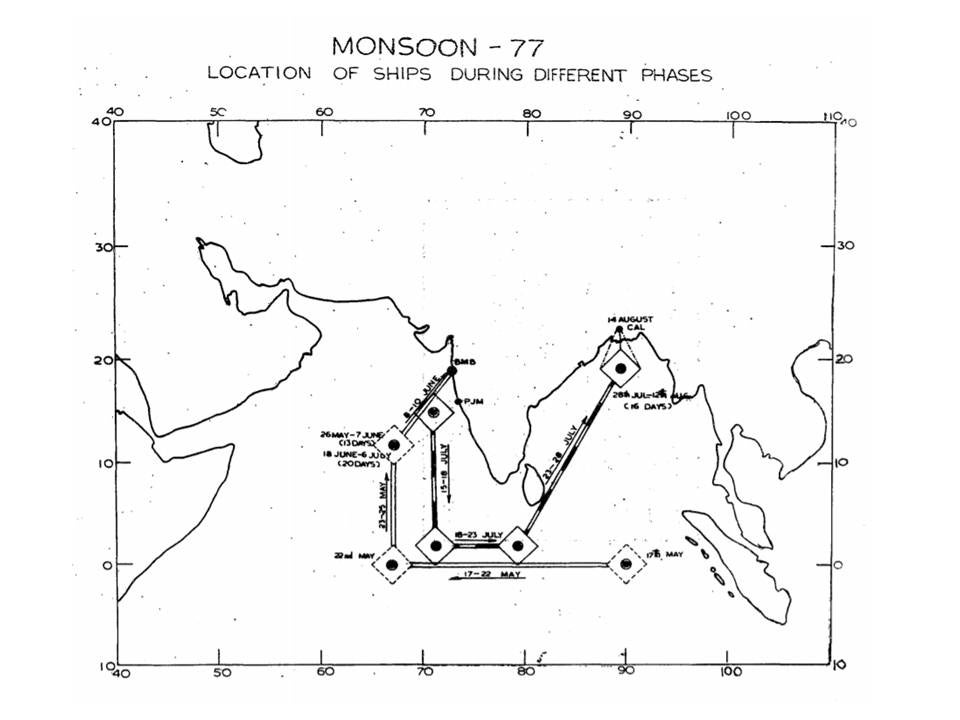MONEX-77
Monsoon Experiment - 1977
The Monsoon Experiment (MONEX) was the core of the Global Atmospheric Research Program (GARP) Monsoon subprogram, which was a major international effort to achieve a better understanding of the planetary monsoon circulation, the major seasonal perturbation of the general circulation of the atmosphere, and the influence of the annual cycle of precipitation associated with the monsoon on the agriculture of the many populous nations of the region. The 1977 Monsoon Experiment (MONEX-77) was conducted over the equatorial Indian Ocean, Arabian Sea, and the Bay of Bengal from May to August 1977 with participation from the U.S., U.S.S.R., India, Malaysia, Mozambique, Oman, Pakistan, Singapore, Sri Lanka, Somalia, and Thailand. The implementation of MONEX-77 was conducted in 3 stages (or periods of intensive observations) with ships at fixed locations, coinciding with the stages of the monsoon [26 May to 7 June (period of onset), 18 June to 6 July (period of establishment), and 28 July to 12 August (period of maximum depressions)]. A temporary meteorological support Center was established at the East Africa Marine Fisheries Research Organization (EAMFRO), Mombasa, in Spring, 1977, with Operations Centers established in Bombay and Calcutta during the field project.
.jpg?itok=70dcLD5H) |
SCIENTIFIC OBJECTIVES
The scientific objectives of MONEX-77 had greater emphasis on the regional aspects of the Monsoon, namely: (1) Development and maintenance of the mean monsoon circulation; (2) Studies on the structure of synoptic systems, and conditions that favor the development of cloud systems and rainfall; (3) Transfer processes and atmospheric structure in the planetary boundary layer and the lower troposphere; and (4) Coupling mechanisms between the troposphere and the lower stratosphere during the monsoon period.
In addition, a numerical experimentation program was part of the scientific objectives (above) including: (1) Latent heat of condensation, enthalpy potential, and total energy of a unit atmospheric column between isobaric levels; (2) Change in the above mentioned characteristics in this column due to large scale motions; (3) Turbulent fluxes of latent heat of condensation and enthalpy from the ocean to the atmosphere; (4) Effect of sub-grid scale processes and radiative fluxes on numerical prediction; and (5) Interaction between motion on different scales during different phases of the monsoon.
Finally, an Oceanographic program concentrated on the Somali and equatorial currents and their associated upwelling. These play an important role in the ocean-atmosphere feedback mechanism which comprises the monsoon system. Moreover, the variability of the monsoon permits study of the time-dependent response of the ocean to atmospheric forcing.
OBSERVATIONS
| Aircraft | NCAR Electra |
| Oceanographic | Standard observations from ships with temporary Buoys deployed in the vicinity of stationary ship deployments |
| Radar | Coastal radar observations from India, Pakistan, Malaysia, and Thailand |
| Ship | 5 research vessels (USSR), 2 research vessels (India), and ships of opportunity |
| Surface | Routine observations from the World Weather Watch (WWW) network |
| Surface | Special micrometeorological stations |
| Upper Air | Routine observations from the World Weather Watch (WWW) network, including additional releases during special observing periods at selected stations in the region |
| Upper Air | Rocket soundings from Thumba and Sriharikota (India) |
| Upper Air | Double theodolite measurements from 3 sites in Somalia (US) |
| Upper Air | Pilot Balloon (PIBAL) observations from special stations (Somalia) and ships (USSR) |
MAP
 |
Principal Investigators:
- Henry Van De Boogaard
- Joach Kuettner
Data Manager:
- EOL Archive NCAR/EOL/DMS